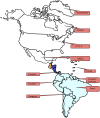[Epidemiology of Q fever in Spain (2018)]
- PMID: 30027720
- PMCID: PMC6194867
[Epidemiology of Q fever in Spain (2018)]
Abstract
Q fever is an anthropozoonosis whose causative agent is Coxiella burnetii, which has an important impact from the human and animal health point of view. In this review, a brief historical reference of the infection by C. burnetii and Q fever has been made initially. In a second section the basic epidemiological aspects of this infection are described (reservoirs/ sources of infection, form of transmission and epidemiological forms). Subsequently, the data of the infection by C. burnetii in Spain will be are indicated, particularly the clinical series, the seroepidemiological studies in humans, the affectation of different types of mammals and the participation of the ticks in the biological cycle. In addition, basic data on C. burnetii infection/ disease in other regions of the world will be are also included. Finally, and taking into account the previous data will indicate the main epidemiological characteristics of Q fever at present.
La fiebre Q es una antropozoonosis cuyo agente causal es Coxiella burnetii que presenta una repercusión importante desde el punto de vista de la salud humana y animal. En esta revision, inicialmente se ha realizado una breve referencia histórica de la infección por C. burnetii y la fiebre Q. En un segundo apartado se describen los aspectos epidemiológicos básicos de esta infección (reservorios/fuentes de infección, forma de transmisión y formas epidemiológicas). Posteriormente se indican los datos de la infección por C. burnetii en España, tanto las series clínicas, los estudios seroepidemiológicos en humanos, la afectación de diferentes tipos de mamíferos y la participación de las garrapatas en el ciclo biológico. Además, se incluyen los datos básicos de la infección/enfermedad por C. burnetii en otras regiones del mudo. Finalmente, y teniendo en cuenta los datos previos se indican las principales características epidemiológicas de la fiebre Q en la actualidad.
©The Author 2018. Published by Sociedad Española de Quimioterapia. This article is distributed under the terms of the Creative Commons Attribution-NonCommercial 4.0 International (CC BY-NC 4.0)(https://creativecommons.org/licenses/by-nc/4.0/).
Conflict of interest statement
Los autores declaran no tener ningún conflicto de intereses.
Figures









Similar articles
-
Seroepidemiological and molecular investigation of spotted fever group rickettsiae and Coxiella burnetii in Sao Tome Island: A One Health approach.Transbound Emerg Dis. 2020 Jul;67 Suppl 2:36-43. doi: 10.1111/tbed.13191. Epub 2019 Jun 24. Transbound Emerg Dis. 2020. PMID: 31231971
-
On the possible role of ticks in the eco-epidemiology of Coxiella burnetii in a Mediterranean ecosystem.Ticks Tick Borne Dis. 2018 Mar;9(3):687-694. doi: 10.1016/j.ttbdis.2018.02.014. Epub 2018 Feb 21. Ticks Tick Borne Dis. 2018. PMID: 29478883
-
Detection of Lyme Disease and Q Fever Agents in Wild Rodents in Central Italy.Vector Borne Zoonotic Dis. 2015 Jul;15(7):404-11. doi: 10.1089/vbz.2015.1807. Epub 2015 Jul 2. Vector Borne Zoonotic Dis. 2015. PMID: 26134933 Free PMC article.
-
Prevalence of Coxiella-infections in ticks - review and meta-analysis.Ticks Tick Borne Dis. 2022 May;13(3):101926. doi: 10.1016/j.ttbdis.2022.101926. Epub 2022 Feb 16. Ticks Tick Borne Dis. 2022. PMID: 35190334 Review.
-
The relevance of the wild reservoir in zoonotic multi-host pathogens: The links between Iberian wild mammals and Coxiella burnetii.Transbound Emerg Dis. 2022 Nov;69(6):3868-3880. doi: 10.1111/tbed.14758. Epub 2022 Nov 26. Transbound Emerg Dis. 2022. PMID: 36335588 Review.
Cited by
-
Murine typhus as the leading cause of non-focalized fever in the Canary Islands.Eur J Clin Microbiol Infect Dis. 2025 Feb;44(2):323-332. doi: 10.1007/s10096-024-04976-8. Epub 2024 Nov 29. Eur J Clin Microbiol Infect Dis. 2025. PMID: 39612139 Free PMC article.
-
A Comprehensive Review of the Mechanisms of Human Q Fever: Pathogenesis and Pathophysiology.Pathogens. 2025 Jun 14;14(6):589. doi: 10.3390/pathogens14060589. Pathogens. 2025. PMID: 40559597 Free PMC article. Review.
-
A Q fever outbreak associated to courier transport of pets.PLoS One. 2019 Nov 25;14(11):e0225605. doi: 10.1371/journal.pone.0225605. eCollection 2019. PLoS One. 2019. PMID: 31765433 Free PMC article.
-
Q Fever Endocarditis: A Challenging Diagnosis in a Patient Referring Weight Loss and Anorexia, and With Granulomas in Gastric Biopsy Specimens.Clin Case Rep. 2024 Nov 29;12(12):e9635. doi: 10.1002/ccr3.9635. eCollection 2024 Dec. Clin Case Rep. 2024. PMID: 39619303 Free PMC article.
-
Host Genetic Factors in Q Fever Susceptibility.Pathogens. 2025 Apr 18;14(4):394. doi: 10.3390/pathogens14040394. Pathogens. 2025. PMID: 40333225 Free PMC article.
References
-
- Alarcón A. Fiebre Q: todavía muchas preguntas por responder. Enferm Infecc Microbiol Clin 2007; 25: 165-7. PMID: - PubMed
Publication types
MeSH terms
LinkOut - more resources
Full Text Sources

